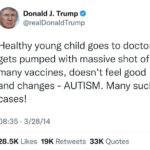Grok summary of Dissolving Illusions: “Dissolving Illusions: Disease, Vaccines, and the Forgotten History” by Suzanne Humphries, MD, and Roman Bystrianyk challenges the conventional narrative about the role of vaccines in reducing infectious diseases. Here are the main takeaways based on the book’s central arguments:
1 Decline in Disease Predates Vaccines: The authors argue that mortality rates from many infectious diseases, such as smallpox, measles, and scarlet fever, began to drop significantly in the mid-19th to early 20th centuries—well before the widespread introduction of vaccines. They present historical data and graphs to suggest this trend was already underway due to other factors.
2 Role of Sanitation and Nutrition: Humphries and Bystrianyk emphasize that improvements in public health—such as better sanitation, clean water, sewage systems, and improved nutrition—played a far greater role in reducing disease mortality than vaccines. They describe how filthy living conditions, overcrowding, and malnutrition historically fueled high disease rates, and how addressing these issues led to dramatic health improvements.
3 Questioning Vaccine Effectiveness: The book contends that vaccines have been overstated as the primary reason for disease eradication. It highlights instances where diseases declined without vaccines or where vaccinated populations still experienced outbreaks, suggesting that vaccines may not be as effective as commonly believed.
4 Historical Context of Poor Living Conditions: The authors paint a vivid picture of 19th-century life—poverty, child labor, lack of hygiene, and contaminated food and water—to argue that these conditions, not a lack of vaccines, were the real drivers of disease prevalence. They assert that modern medicine often overlooks this context.
5 Critique of Medical Narratives: Humphries and Bystrianyk challenge the medical establishment’s portrayal of vaccines as a near-miraculous solution, suggesting that this belief stems from a combination of fear, propaganda, and selective historical interpretation. They argue that the true history of disease prevention has been overshadowed by a vaccine-centric storyline.
6 Potential Risks of Vaccines: The book raises concerns about vaccine safety, pointing to historical examples of contaminated vaccines and adverse effects. It suggests that the long-term impacts of vaccines are understudied and that parents should approach vaccination with skepticism rather than blind trust.
These takeaways reflect the authors’ core thesis: that the decline in infectious diseases is a complex story involving multiple societal improvements, and that the role of vaccines has been exaggerated while their risks are downplayed. The book encourages readers to critically evaluate public health narratives and consider alternative explanations for historical health trends.













